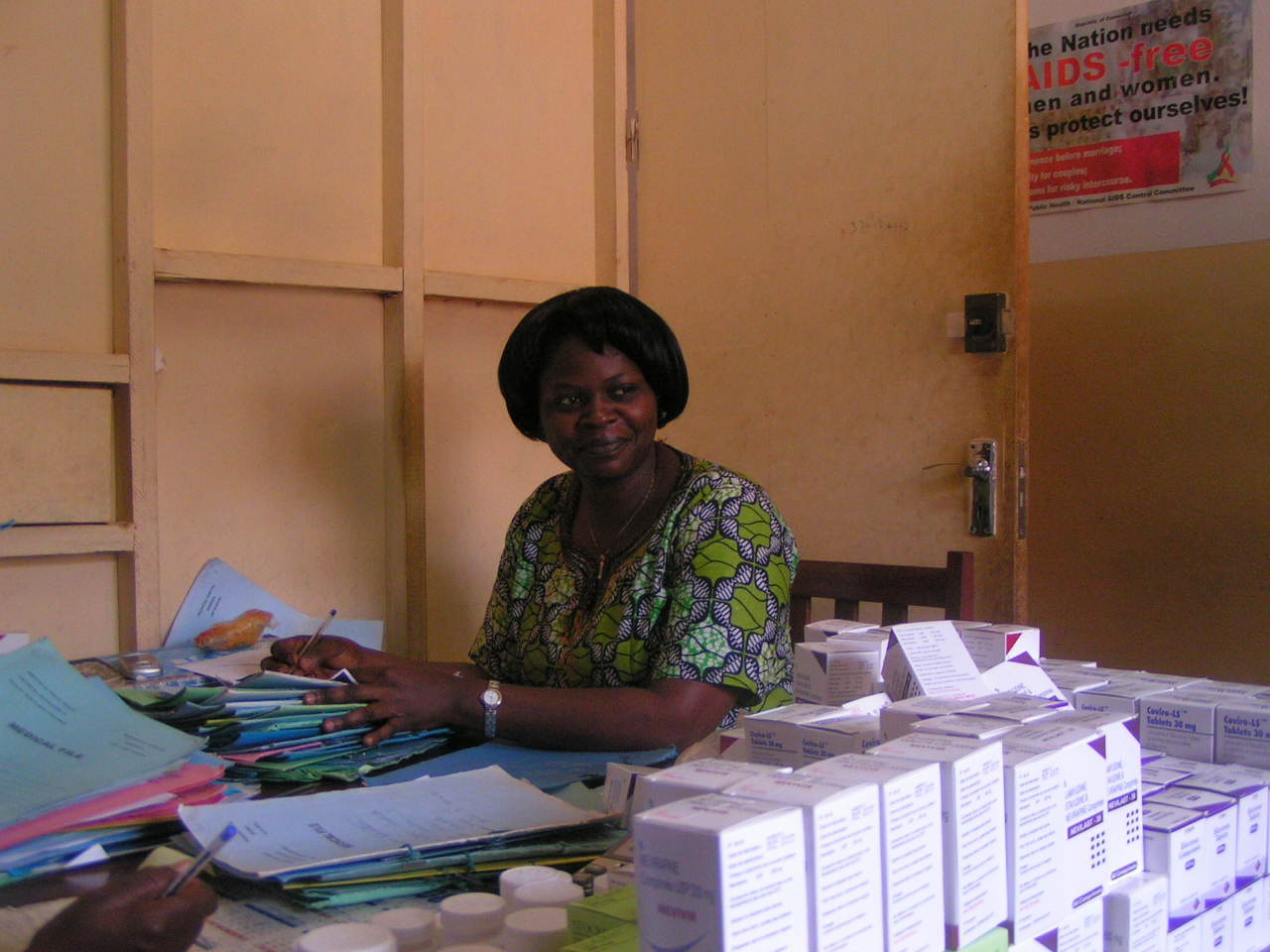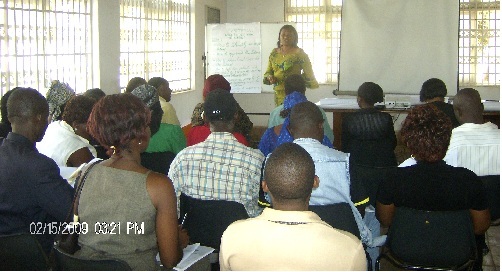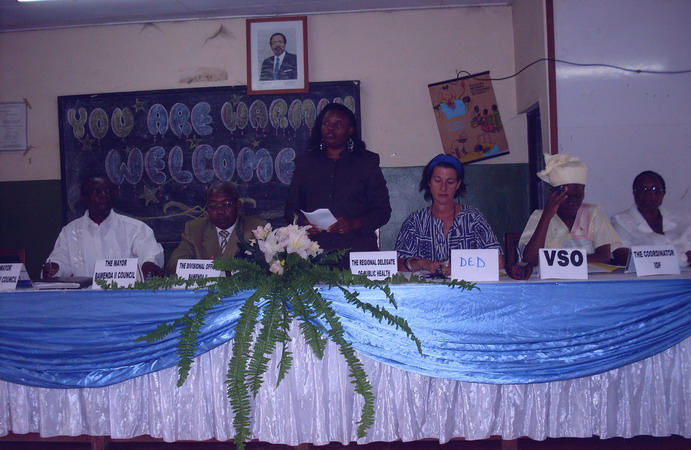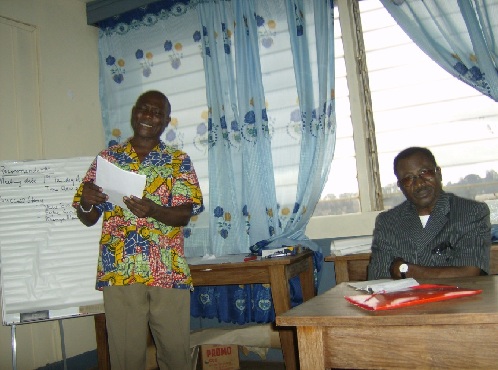Home Based Care
What is Home Based Care?
An approach that combines clinical services, nursing care, counseling and psycho spiritual care, and social support. If represents a continuum of care, from the health facility to the community, to the family, to the individual infected with HIV / AIDS, and back again. It includes the care given to sick and affected in their own homes and extends from the hospital or health facility to their home through family participation and community involvement. This is a collaborative effort between hospital, family and community. It include component such as physical, psychological and spiritual support.
Home Based Care (2006 to 2009)
Description
Home Based Care (HBC) provides comprehensive services in the home, including health and social services by formal and informal caregivers. HBC includes psychological, palliative and spiritual activities. IDF’s role was to provide community relay agents (CRAs) who visit clients in their homes as well as to supervise the community work and act as a link between the community and the day hospital.
Project Context
In 2005 HBC was chosen by the Government as the latest approach to effectively combat HIV/AIDS and its impact since the first approaches did not yield significant impacts on the prevalence rate. IDF was selected through a competitive process in 2006 as the NGO to support the implementation of home based care in the North West Region.
Activities
CRAs were intended to carry out work in both the treatment centres as well as the community. Some of their activities were to include informing the community about health services offered at the treatment centre, carrying out home visits providing care and support, promoting family and community awareness of HIV and other diseases to increase prevention and reduce stigma, make referrals of clients to health units and social facilities, and empower clients in self care and positive living. 
CRA working in pharmacy
However, due to a shortage of staff in the treatment centres CRAs carried out a variety of other activities in the treatment centres such as sorting files, registering and weighing clients, helping clients with the collection of drugs, assisting in giving out Bactrim, providing pre and post counselling to clients and positive clients, assisting disabled clients get around the treatment centre, giving information sessions and giving free testimonies.
Results and Impacts
The initial HBC program was able to reach on average over 7500 people living with HIV and AIDS each month and provided services such as carrying out prevention sessions, nutritional counseling sessions, therapeutic education sessions, educational talks, follow ups with patients, field visits, referrals, and pre and post test counseling.
There were a number of strengths that were identified in the HBC program. First, the practical talks and testimonies were seen to be quite effective as a practical, participatory approach to information about HIV. Second, CRAs were very helpful to the hospital staff in keeping clients arranged in the hall and helped maintain the smooth function of staff activities. Lastly, CRAs helped reduce the waiting time and enabled the provision of faster services.
A number of weaknesses were also identified and were seen to be significant impediments to continuing the program as it was initially conceived. First, there was no referral system in existence and community clients sent referred by CRAs did not get special treatment at the centres. Secondly, the activities in the community were criticized to be little given that CRAs spent more time at the treatment canters than on home visits. Lastly, the lags in the allowance system made it difficult for CRAs to travel for field work.
Difficulties Faced
- The initial Home-Based Care program had some weaknesses: in addition to those mentioned (on the left) the field work activity was not effectively performed and the area to cover by each CRAs was very large.
Way Forward/Recommendations
- In light of the weaknesses in the HBC project as it was initially conceived, and the difficulties faced, IDF proposed an improved system. The new system involved using the services of well trained Community Volunteers (CVs) living in various quarters in order to deliver proximity and quality services to the clients.
Developing a New Approach to Home Based Care
The initial Home Based Care (HBC) program which was implemented in 2006 has a number of flaws, therefore in order to improve the quality of services received, IDF developed a new approach to the HBC program with the support of VSO.
Before the new approach to HBC was implement IDF undertook a number of activities ensure that it was well thought out and that the actors were well trained.
Given that the initial HBC program area of intervention was too large to be manageable, IDF carried out a mapping exercise to set a new area of intervention. In addition to setting the area of intervention, IDF also identified the relevant clients by going through client files from 2004 to 2008 at the Day Hospital and sorting out all the clients by quarter within IDF’s area of intervention. This helped to determine the concentration of clients per quarter.
 Community Volunteer Orientation
Community Volunteer Orientation
One of the weaknesses of the initial HBC program was that CRAs did not have enough time to spend on home visits, therefore IDF decided that there should be community volunteers who take on the home visit responsibility so the CRAs could continue their work in the treatment centers which was their strength. IDF identified community volunteers (CVs) with the help of Quarter heads, leaders of Associations of People Living with HIV and AIDS, and Support Groups and CRAs. The selection criteria used was based on their experience in HIV/AIDS and their ability to communicate.
The CVs were trained with technical assistance from VSO. Training for CVs is a continuous process since they cannot acquire all the knowledge and skills for effective Home Based Care in one training session. Monthly meetings include trainings, and trainings on specific topics are also carried out throughout the year.
In order to ensure that the quality of activities are consistent between and across CVs and clients, as well as to ensure that the objectives of the program are being met, IDF developed a monitoring and evaluation system with the support of VSO. This system ensures that the CVs record their activities and their impacts with their clients, thereby providing data for concrete analysis of the program impacts.
The new approach received the approval of the Ministry of Public Health through the Regional Delegation of Public Health in Bamenda in April 2009 after extensive meetings. The event was launched with the Swearing-In ceremony of the CVs. After speeches by the Regional Delegation of Public Health, VSO, IDF and other stakeholders, the CVs declared in the presence of all those present their readiness to work within the norms and principles laid down governing the programme.
 Swearing in Ceremony for CVs
Swearing in Ceremony for CVs
Advantages of the new system:
- CVs are able to carry out frequent home visits with the clients due to their close proximity which will result in the possible increase in drug adherence, and reduce stigmatisation.
- Provision of effective and quality services to people living with HIV and AIDS as well as preventive education that will reduce discrimination and stigmatisation.
- Strengthened collaboration and partnership between community base services, Day Hospital and in-patient care.
 Officials at Swearing in Ceremony
Officials at Swearing in Ceremony
The New Home Based Care
Description
The New Home Based Care (HBC) provides comprehensive services in the home, including health and social services by formal and informal caregivers. HBC includes psychological, palliative and spiritual activities. HBC is carried out by Community Volunteers (CVs) and Community Relay Agents (CRAs)
 Community Volunteers
Community Volunteers
Project Context
After her experience with the initial HBC program developed by the government, IDF proposed a new system to address some of the difficulties that existed in the old system. Given that the role of a HBC program is to build a link between the community and Health Services, IDF’s proposed system involved the community substantially. CVs were chosen within the quarters in the area of intervention and were paired with clients in those quarters to facilitate the ease of carrying out home visits. CRAs continued working both at the treatment centers and in the community but focused predominantly on improving the services at the treatment centers.
Activities
Under the new HBC program the following activities were carried out by CVs:
- Counseling
- Care and support
- Raising awareness with community members and clients on issues such as prevention and transmission of HIV
- Training family members on home based care
- Ensuring drug therapy adherence
 Community Volunteers at a Monthly Meeting
Community Volunteers at a Monthly Meeting
CRAs carried out the following activities:
- Referring HIV clients to a community volunteer for follow-up
- Providing support to clients who need to visit the hospital
- Carrying out home visits to follow up hospital visits
IDF carried out the following activities:
- Coordinating monthly meetings for CVs
- Organizing training for CVs on malaria and prevention of mother to child transmission of HIV
Results and Impacts
The new HBC program has yielded positive results and has carried out a number of activities. As of August 2010, after 6 months of the program, over 1000 people had been reached through the work of the community volunteers and the relay agents. In November 2010, 118 people were identified as clients in the home based care program and received food baskets as part of IDF’s World AIDS Day activities.
Difficulties Faced
The HBC program was suspended by the Cameroon government in 2010 due to budget constraints. This however, did not stop IDF from continuing its HBC activities. IDF recognized that he hospital staff would be overburdened and understaffed without the support from CRAs and CVs in this domain. Therefore IDF placed an international DED volunteer with the CTA to assist with filling three days a week over three months. IDF also encouraged CVs and CRAs to continue their work on a voluntary basis. CARE Cameroon provided 3.5 months of interim funding.
Lessons Learned
- Community volunteering on HIV/AIDS is welcomed by all the stakeholders involved in the fight against HIV/AIDS.
- Community home based care is the right way of mitigating the impact of the pandemic.
- No action can work properly if all the actors do not work hand in hand with the Government services.
- RDPH is at the center of the process playing a role of technical adviser and backstopping.
- Civil society organizations are appreciated and valued by the RDPH.
Way Forward/Recommendations
IDF continues to strive towards building links between the health facilities and the community. IDF, with the support of VSO, is working on strengthening the relationship with the RDPH in order to work towards improving the quality of services clients.